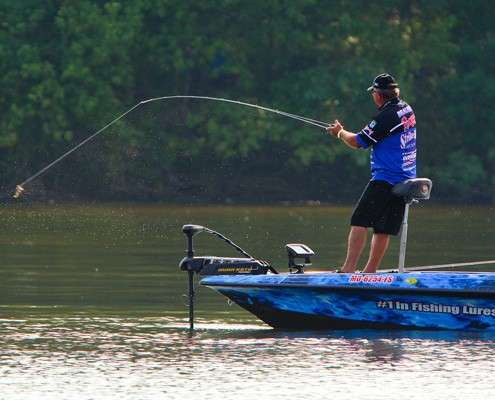
This time we're going to talk dock fishing, but not just any docks. We're going to concentrate on those that'll produce fish with a flipping and pitching technique during the hottest summer months.
The first thing you should understand is that bass holding on summer boat docks are keying on bluegill. Walk out on any dock, and what do you see? Almost always it'll be scads of bluegill. Therefore you want a bait that matches the hatch.
My preference is the Denny Brauer 1/2-ounce Premier Pro-Model Jig in Texas craw with a green pumpkin Strike King Rage Tail Craw behind it. There's nothing that I know of that looks as much like a bluegill as that combination. It's the backbone of my summer dock flipping and pitching, no matter where I'm fishing.
When you're looking for a likely dock, start by searching in the best part of the lake, the area that's most likely to be holding bass. Then choose your dock. Think about the dock as a bonus piece of cover. It's almost a secondary consideration.
For instance, if a dock's on a main lake point or along a channel swing, it's probably going to be a good one. This is summertime. The water's hot. The bass are likely deep, or at least relating to deep water. On the other hand, if a dock's back in a shallow spawning cove it's not likely to produce regardless of how good it looks to you as an angler.
Once you're in the right area of the lake, look for docks that have some vertical connection with the bottom. They're almost always the best. If a dock is set on poles, start on the outside corners. I catch most of my bass off those two corners.
If there's no vertical connection to the bottom, you'll have to pick a few apart to find the most productive pattern. Start by fishing the deepest, blackest shade you can find. Pick every nook and cranny apart. Work slowly and carefully. Pay attention to every detail no matter how small or insignificant it may seem at the time.
This is where flipping and pitching accuracy — and skipping skills — comes into play. Often you'll need to get your jig back into places where no one else can, or even has the nerve to try. That gives you the opportunity to fish new water on even the most heavily pressured lake or river and to develop a pattern no one else can duplicate.
Having said all that, keep in mind that dock fishing is an art form. There's no substitute for practice and experience. Some days you'll need to make repeated casts to every dock before you uncover the pattern of the day. Other times one or two casts to the outside corners, or maybe even somewhere else, will get you a kicker or two.
At times, fishing summer docks can be tough going. One thing is for certain, though. There are always a few bass hiding under docks in the middle of the summer, and they can be caught by persistent anglers flipping and pitching the right bait.





